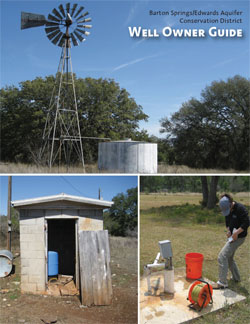Well Owner Resources
Well Owner Guide
Groundwater is a shared resource, and all well owners can do their part to help protect water quality and availability now and for years to come. The Well Owner Guide covers a wide variety of important information including:
- Well head protection
- Well construction
- Water quality
- Well maintenance
- Drought impacts
- Water conservation
- Aquifer management
You can download your copy of the guide here.
How to Search for a Well Log
Since 2003, well drillers have been required to submit well logs online; this makes them relatively easy to find through the Texas Water Development Board’ Water Data Interactive map. Prior to 2003, well drillers submitted hardcopy logs to TCEQ; many of these logs have been cataloged according to well grid and (if luck is on your side) can be found by searching pdfs available through TCEQ’s historic well log viewer. Here are some tips and tricks, depending on the date your well was drilled.
Drill Date: 2003 – present
Search for Submitted Well Driller Reports through TWDB Water Data Interactive
- Use Water Data Interactive’s address search and type in your address.
- Under the Groundwater tab, check the box for Well Reports (look for orange dots). Note: purple dots are wells that have either water level or water quality data.
- Use your mouse to click on an orange dot to open the popup window with well details.
- Select the hyperlinked Well Report Tracking Number to open a pdf version of the Submitted Well Driller’s Report.
Drill Date: prior to 2003
- Use Hays CAD to find original owner & Section/lot number (this will be helpful because some scanned documents do not reference a street number)
- Open TCEQ’s historic well viewer and zoom into neighborhood of interest.
- Identify the grid number that corresponds to your location of interest. Note: before GPS was widely available, drillers used a statewide grid system to approximate locations for wells.
- Select Plotted Water Well Reports & fill in Grid Number and County (Ex.: 68-08-5, Hays)
- Open first pdf and scroll through visually searching for Owner, Address or Section/Lot of interest.
- If you find it, CELEBRATE!!!!!
- Print that 1 page (not the whole pdf).
Instructions for Submitting Water Samples
Prep Sample Site
- Wash your hands.
- Use an unfiltered faucet as close to the well as possible for making the collection. If an inside faucet is used, remove the aerator on the end of the faucet before making the collection.
- Rinse and dry exterior of the faucet to prevent exterior contamination of your water sample. If possible, wipe off with a Clorox-type towelette or paper towel wetted with a light bleach solution to kill any bacteria present on the faucet. Allow the solution to dry before sampling.
- Turn on the water full force and let it run at full force for two minutes.
- Reduce the water flow to a small stream***Fill both the bag AND the bottle*** Results are expected to be provided to well owners the week of March 7.
Bottle
- Only open the sample bottle when you are immediately about to collect the sample.
- Do not touch the inside of the bottle or lid.
- Fill the water just above the 100mL line to ensure none of the powder contained in the bottle escapes. This powder is present to neutralize chlorine.
- Close the bottle tightly immediately after the sample is collected.
Bag
- Tear off the perforated strip above the yellow twist ties from the top of the bag. Grasp the small white tabs on the side of the water-sampling bag and pull the bag open (be careful not to touch the inside of the bag with your fingers)
- Holding the bag by the yellow twist ties, fill the sampling bag three-fourths full and then twirl the bag top over bottom to close it. Some water may leak out, but don’t worry. Tie the twist ties together.
PLEASE NOTE: All samples should be collected within 24 hours of the analysis date (Thursday, March 3) to ensure accurate results. The sample must be less than 24 hours old.
Return your sample (bag, bottle, and completed water sample form) to the District Office (1124 Regal Row, Austin, TX 78748) between 5:00 p.m. on Wednesday, March 2 and 9:30 a.m. on Thursday, March 3. We will have a cooler by the main entrance of the District office for drop-off.
How To Take A Water Sample:
Why Test Well Water?
Private water wells should be tested annually for contaminants that can jeopardize the health of its users, especially vulnerable populations like children, the elderly, or those with compromised immune systems.
Water Quality Resources
There are a variety of local laboratories that can test residential well samples. If you missed the Water Well Check-up or would like to verify your results, you can contact a local lab to coordinate the analysis.
The US EPA and many groundwater conservation districts (including the District) still recommend that private water well owners test their well water annually for contaminants that can jeopardize the health of users, especially vulnerable populations like children, the elderly, or those with compromised immune systems. You can have your samples tested by an accredited lab at any time.
Local Water Quality Labs |
|
Interpreting Your Results |
|
Treating Your Water |
|







